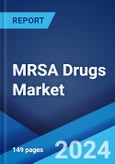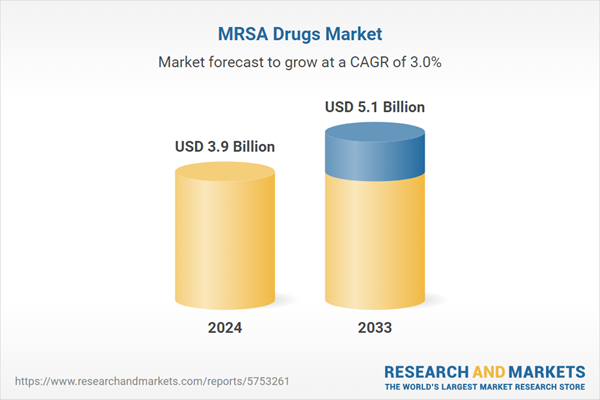The global MRSA drugs market size reached USD 3.9 Billion in 2024. Looking forward, the publisher expects the market to reach USD 5.1 Billion by 2033, exhibiting a growth rate (CAGR) of 2.95% during 2025-2033. The rising prevalence of antibiotic resistant strains development, continual exposure to multidrug-resistant organisms in healthcare facilities due to prolonged hospital admission and the growing number of clinical trials represent some of the key factors driving the market.
Methicillin-resistant staphylococcus aureus (MRSA) is an infection caused by antibiotic-resistant strains of staphylococcus aureus that generally occurs in patients who undergo surgical procedures, receive intravenous tubing, or come in contact with each other skin-to-skin. The MRSA drugs are used as antimicrobial agents against methicillin-resistant staphylococcus aureus infection in order to kill or restrain it. They inhibit the actions of pathogens while enhancing the patient's cellular synthesis and immunity. The most common MRSA drugs consist of trimethoprim-sulfamethoxazole, clindamycin, minocycline, linezolid, or doxycycline. These drugs are generally used as oral medication, usually on a course of seven to ten days. MRSA infections can arise from hospitals or from community, hence the treatment for MRSA can sometimes involve the administration of oral medications and intravenous (IV) medications, depending on the severity. There are a wide variety of MRSA drugs available that can be used for the treatment of different types of infections, including skin infections, bone infections, bacteremia, and even zoonotic infections in animals.
Methicillin-resistant staphylococcus aureus (MRSA) is an infection caused by antibiotic-resistant strains of staphylococcus aureus that generally occurs in patients who undergo surgical procedures, receive intravenous tubing, or come in contact with each other skin-to-skin. The MRSA drugs are used as antimicrobial agents against methicillin-resistant staphylococcus aureus infection in order to kill or restrain it. They inhibit the actions of pathogens while enhancing the patient's cellular synthesis and immunity. The most common MRSA drugs consist of trimethoprim-sulfamethoxazole, clindamycin, minocycline, linezolid, or doxycycline. These drugs are generally used as oral medication, usually on a course of seven to ten days. MRSA infections can arise from hospitals or from community, hence the treatment for MRSA can sometimes involve the administration of oral medications and intravenous (IV) medications, depending on the severity. There are a wide variety of MRSA drugs available that can be used for the treatment of different types of infections, including skin infections, bone infections, bacteremia, and even zoonotic infections in animals.
MRSA Drugs Market Trends:
The rising prevalence of antibiotic resistant strains development among the masses is a significant factor driving the growth of the market. This can be attributed to the increase in the number of cases of hospital-acquired infections (HAIs) on the global level. Also, the continual exposure to multidrug-resistant organisms in healthcare facilities due to prolonged hospital admission is resulting in the development of secondary nosocomial infections, thereby propelling the market. In addition to this, the growing geriatric population that is more susceptible to developing MRSA infections is providing an impetus to the market. Moreover, the augmenting awareness regarding different forms of bacterial infection is leading to a higher uptake of MRSA drugs. In line with this, numerous product innovations, growing number of clinical trials and the introduction of novel drug variants are creating lucrative growth opportunities in the market. However, the high costs involved in developing novel MRSA drug variants is acting as major growth restraining-factor for the market. On the contrary, continual technological developments in various diagnostic tools, along with the increasing number of clinical trial programs for the screening of antibiotic resistant strains of bacteria, are creating a positive market outlook. The market is further impelled by extensive research and development (R&D) activities conducted by the key players. Some of the other factors contributing to the market include the emergence of generic drugs against presently available products, easy availability of antibiotics across online and offline organized platforms, rapid urbanization, and increasing medical expenditure.Key Market Segmentation:
The publisher provides an analysis of the key trends in each segment of the global MRSA drugs market, along with forecasts at the global, regional, and country level from 2025-2033. Our report has categorized the market based on MRSA type, drug class, disease indication, route of administration, and distribution channel.MRSA Type Insights
- Hospital-Acquired (HA-MRSA)
- Community-Acquired (CA-MRSA)
Drug Class Insights
- Lipopeptides
- Oxazolidinones
- Cephalosporin
- Tetracycline
- Folate Antagonist
- Others
Disease Indication Insights
- Skin Infections
- Bone and Joint Infections
- Bacteremia
- Animal Infections
Route of Administration Insights
- Oral Administration
- Parenteral Administration
Distribution Channel Insights
- Hospital Pharmacies
- Retail Pharmacies
- Online Pharmacies
Regional Insights:
- North America
- United States
- Canada
- Asia Pacific
- China
- Japan
- India
- South Korea
- Australia
- Indonesia
- Others
- Europe
- Germany
- France
- United Kingdom
- Italy
- Spain
- Russia
- Others
- Latin America
- Brazil
- Mexico
- Others
- Middle East and Africa
Competitive Landscape
The report has also provided a comprehensive analysis of the competitive landscape in the global MRSA drugs market. Detailed profiles of all major companies have also been provided. Some of the companies covered include AbbVie Inc., Basilea Pharmaceutica Ltd, Crystal Genomics Inc., Cumberland Pharmaceuticals Inc., Melinta Therapeutics Inc, Paratek Pharmaceuticals, Inc., Pfizer Inc, etc.Key Questions Answered in This Report:
- How has the global MRSA drugs market performed so far and how will it perform in the coming years?
- What are the drivers, restraints, and opportunities in the global MRSA drugs market?
- What are the key regional markets?
- Which countries represent the most attractive MRSA drugs markets?
- What is the breakup of the market based on the MRSA type?
- What is the breakup of the market based on the drug class?
- What is the breakup of the market based on the disease indication?
- What is the breakup of the market based on the route of administration?
- What is the breakup of the market based on the distribution channel?
- What is the competitive structure of the global MRSA drugs market?
- Who are the key players/companies in the global MRSA drugs market?
Table of Contents
1 Preface3 Executive Summary13 Value Chain Analysis15 Price Analysis
2 Scope and Methodology
4 Introduction
5 Global MRSA Drugs Market
6 Market Breakup by MRSA Type
7 Market Breakup by Drug Class
8 Market Breakup by Disease Indication
9 Market Breakup by Route of Administration
10 Market Breakup by Distribution Channel
11 Market Breakup by Region
12 Drivers, Restraints, and Opportunities
14 Porters Five Forces Analysis
16 Competitive Landscape
List of Figures
List of Tables
Companies Mentioned
- AbbVie Inc.
- Basilea Pharmaceutica Ltd
- Crystal Genomics Inc.
- Cumberland Pharmaceuticals Inc.
- Melinta Therapeutics Inc
- Paratek Pharmaceuticals Inc.
- Pfizer Inc
Methodology

LOADING...
Table Information
| Report Attribute | Details |
|---|---|
| No. of Pages | 142 |
| Published | March 2025 |
| Forecast Period | 2024 - 2033 |
| Estimated Market Value ( USD | $ 3.9 Billion |
| Forecasted Market Value ( USD | $ 5.1 Billion |
| Compound Annual Growth Rate | 3.0% |
| Regions Covered | Global |
| No. of Companies Mentioned | 7 |









